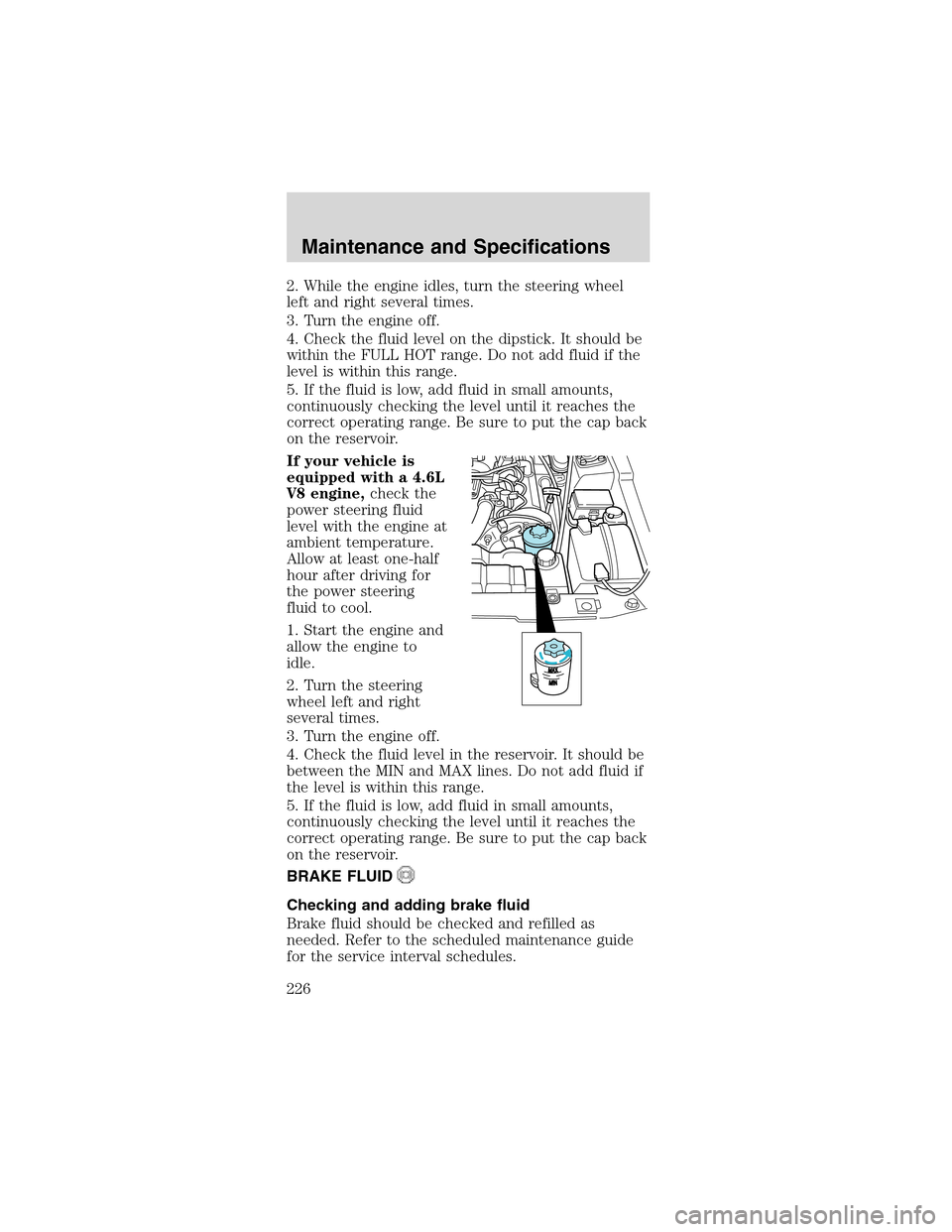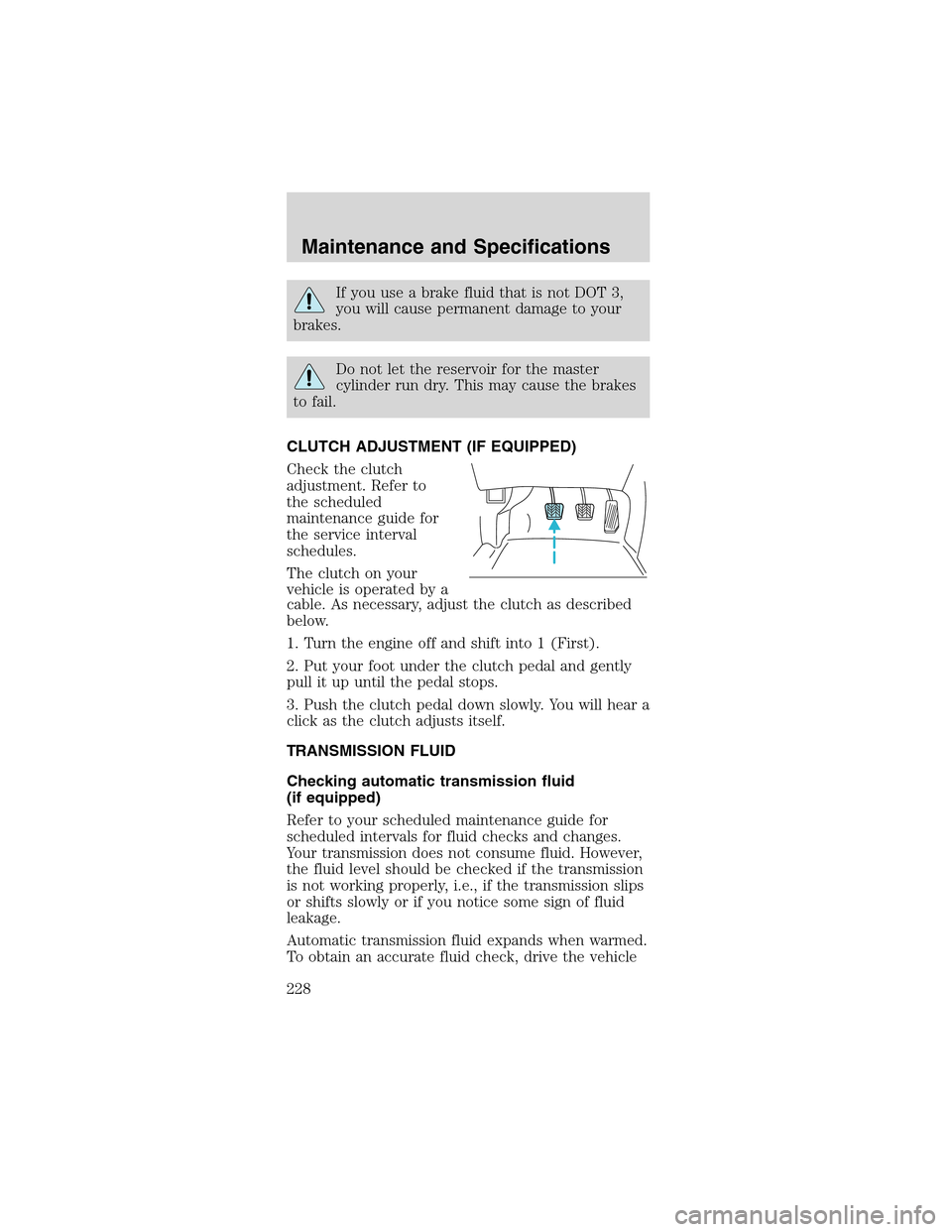Page 225 of 256

If the vehicle’s powertrain system or its battery has
just been serviced, the on-board diagnostics system
is reset to a“not ready for I/M test”condition. To
ready the on-board diagnostics system for I/M
testing, a minimum of 30 minutes of city and
highway driving is necessary as described below:
•First, at least 10 minutes of driving on an
expressway or highway.
•Next, at least 20 minutes driving in stop-and-go,
city-type traffic with at least four idle periods.
Allow the vehicle to sit for at least eight hours
without starting the engine. Then, start the engine
and complete the above driving cycle. The engine
must warm up to its normal operating temperature.
Once started, do not turn off the engine until the
above driving cycle is complete.
CHECKING AND ADDING POWER STEERING
FLUID
Check the power steering fluid. Refer to the
scheduled maintenance guide for the service interval
schedules. If adding fluid is necessary, use only
MERCON�AT F.
If your vehicle is
equipped with the
3.8L V6 engine,check
the power steering
fluid level with the
engine at normal
operating temperature.
1. Start the engine and
let it run until it
reaches normal
operating temperature
(the engine coolant
temperature gauge
indicator will be near
the center of the
normal area between H
and C).
FILL
HOT
Maintenance and Specifications
225
Page 226 of 256

2. While the engine idles, turn the steering wheel
left and right several times.
3. Turn the engine off.
4. Check the fluid level on the dipstick. It should be
within the FULL HOT range. Do not add fluid if the
level is within this range.
5. If the fluid is low, add fluid in small amounts,
continuously checking the level until it reaches the
correct operating range. Be sure to put the cap back
on the reservoir.
If your vehicle is
equipped with a 4.6L
V8 engine,check the
power steering fluid
level with the engine at
ambient temperature.
Allow at least one-half
hour after driving for
the power steering
fluid to cool.
1. Start the engine and
allow the engine to
idle.
2. Turn the steering
wheel left and right
several times.
3. Turn the engine off.
4. Check the fluid level in the reservoir. It should be
between the MIN and MAX lines. Do not add fluid if
the level is within this range.
5. If the fluid is low, add fluid in small amounts,
continuously checking the level until it reaches the
correct operating range. Be sure to put the cap back
on the reservoir.
BRAKE FLUID
Checking and adding brake fluid
Brake fluid should be checked and refilled as
needed. Refer to the scheduled maintenance guide
for the service interval schedules.
MAXMIN
Maintenance and Specifications
226
Page 227 of 256
•3.8L OHV V6 engine
•4.6L SOHC V8
engine
1. Clean the reservoir cap before removal to prevent
dirt or water from entering the reservoir.
2. Visually inspect the
fluid level.
3. If necessary, add
brake fluid from a clean
un-opened container
until the level reaches MAX. Do not fill above this
line.
4. Use only a DOT 3 brake fluid certified to meet
Ford specification ESA-M6C25–A. Refer to
Lubricant specificationsin this chapter.
Brake fluid is toxic. If brake fluid contacts
the eyes, flush eyes with running water for
15 minutes. Seek medical attention if irritation
persists. If taken internally, drink water and induce
vomiting. Seek medical attention immediately.
M
A
X
Maintenance and Specifications
227
Page 228 of 256

If you use a brake fluid that is not DOT 3,
you will cause permanent damage to your
brakes.
Do not let the reservoir for the master
cylinder run dry. This may cause the brakes
to fail.
CLUTCH ADJUSTMENT (IF EQUIPPED)
Check the clutch
adjustment. Refer to
the scheduled
maintenance guide for
the service interval
schedules.
The clutch on your
vehicle is operated by a
cable. As necessary, adjust the clutch as described
below.
1. Turn the engine off and shift into 1 (First).
2. Put your foot under the clutch pedal and gently
pull it up until the pedal stops.
3. Push the clutch pedal down slowly. You will hear a
click as the clutch adjusts itself.
TRANSMISSION FLUID
Checking automatic transmission fluid
(if equipped)
Refer to your scheduled maintenance guide for
scheduled intervals for fluid checks and changes.
Your transmission does not consume fluid. However,
the fluid level should be checked if the transmission
is not working properly, i.e., if the transmission slips
or shifts slowly or if you notice some sign of fluid
leakage.
Automatic transmission fluid expands when warmed.
To obtain an accurate fluid check, drive the vehicle
Maintenance and Specifications
228
Page 229 of 256
![FORD MUSTANG 2003 4.G Owners Manual until it is at normal operating temperature
(approximately 30 km [20 miles]). If your vehicle has
been operated for an extended period at high
speeds, in city traffic during hot weather or pulling a
t FORD MUSTANG 2003 4.G Owners Manual until it is at normal operating temperature
(approximately 30 km [20 miles]). If your vehicle has
been operated for an extended period at high
speeds, in city traffic during hot weather or pulling a
t](/manual-img/11/5211/w960_5211-228.png)
until it is at normal operating temperature
(approximately 30 km [20 miles]). If your vehicle has
been operated for an extended period at high
speeds, in city traffic during hot weather or pulling a
trailer, the vehicle should be turned off for about 30
minutes to allow fluid to cool before checking.
1. Drive the vehicle 30 km (20 miles) or until it
reaches normal operating temperature.
2. Park the vehicle on a level surface and engage the
parking brake.
3. With the parking brake engaged and your foot on
the brake pedal, start the engine and move the
gearshift lever through all of the gear ranges. Allow
sufficient time for each gear to engage.
4. Latch the gearshift lever in P (Park) and leave the
engine running.
5. Remove the dipstick, wiping it clean with a clean,
dry lint free rag. If necessary, refer toIdentifying
components in the engine compartmentin this
chapter for the location of the dipstick.
6. Install the dipstick making sure it is fully seated in
the filler tube.
7. Remove the dipstick and inspect the fluid level.
The fluid should be in the designated area for
normal operating temperature or ambient
temperature.
Low fluid level
Do not drive the
vehicle if the fluid level
is at the bottom of the
dipstick and the ambient temperature is above 10°C
(50°F).
Correct fluid level
The transmission fluid should be checked at normal
operating temperature 66°C-77°C (150°F-170°F) on
a level surface. The normal operating temperature
can be reached after approximately 30 km (20
miles) of driving.
Maintenance and Specifications
229
Page 237 of 256
•If possible, avoid fully loading your vehicle.
•Remove the tire chains when they are no longer
needed. Do not use tire chains on dry roads.
•The suspension insulation and bumpers will help
prevent vehicle damage. Do not remove these
components from your vehicle when using snow
tires and chains.
MOTORCRAFT PART NUMBERS
Component 3.8L OHV V6
engine4.6L SOHC V8
engine
Air filter element FA-1611 FA-1634
Fuel filter FG-986 FG-986B
Battery BXT-59 BXT-59
Oil filter FL-400S FL-820S
PCV valve EV-152 EV-98
Spark plugs* AWSF-42EE** AWSF-32P
* Refer to Vehicle Emissions Control Information
(VECI) decal for spark plug gap information.
**If a spark plug is removed for inspection, it must
be reinstalled in the same cylinder. If a spark plug
needs to be replaced, use only spark plugs with the
same service part number suffix letter as shown on
the engine decal.
Maintenance and Specifications
237
Page 238 of 256
REFILL CAPACITIES
Fluid Ford Part
NameApplication Capacity
Brake fluid Motorcraft
High
Performance
DOT 3 Motor
Vehicle Brake
FluidAll Fill to line on
reservoir
Engine oil
(includes
filter change)Motorcraft
SAE 5W-20
Premium
Synthetic
Blend Motor
Oil3.8L OHV V6
engine4.7 L (5.0
quarts)
4.6L SOHC
V8 engine5.7L (6.0
quarts)
Engine
coolant
1Motorcraft
Premium
Engine
Coolant
(green-
colored)or
Motorcraft
Premium
Gold Engine
Coolant
(yellow-
colored)3.8L OHV V6
engine11.2L (11.8
quarts)
4.6L SOHC
V8 engine13.3L (14.1
quarts)
Power
steering fluidMotorcraft
MERCON�
AT F3.8L OHV V6
engineKeep in
FULL HOT
range on
dispstick
4.6L SOHC
V8 engineFill to
between MIN
and MAX
lines on
reservoir
Maintenance and Specifications
238
Page 239 of 256

Fluid Ford Part
NameApplication Capacity
Rear axle
lubricant
2Motorcraft
SAE 80W-90
Premium
Rear Axle
Lubricant7 .5 inch axle 1.5L (3.25
pints)
Motorcraft
SAE 75W-140
Synthetic
Rear Axle
Lubricant8.8 inch axle 2.0L (4.25
pints)
Fuel tank N/A All 59.4L (15.7
gallons)
Transmission
fluid
3Motorcraft
MERCON�V
AT FAutomatic
with 3.8L
OHV V6
engine13.1L (13.9
quarts)4
Automatic
with 4.6L
SOHC V8
engine12.0L (12.8
quarts)4
Motorcraft
MERCON�
AT FManual with
3.8L OHV V6
engine2.6L (5.6
pints)5
Synthetic
MERCON�
AT FManual with
4.6L SOHC
V8 engine3.8L (8.0
pints)5
Windshield
washer fluidUltra-Clear
Windshield
Washer
ConcentrateAll 3.8L (4.0
quarts)
1Add the coolant type originally equipped in your
vehicle.
2Rear axle lubricants do not need to be checked or
changed unless a leak is suspected, service is
required or the axle assembly has been submerged
in water. The axle lubricant should be changed any
time the rear axle has been submerged in water. Fill
6 mm to 14 mm (1/4 inch to 9/16 inch) below
bottom of fill hole. Add 118 ml (4 oz.) of Additive
Friction Modifier C8AZ-19B546-A or equivalent
Maintenance and Specifications
239